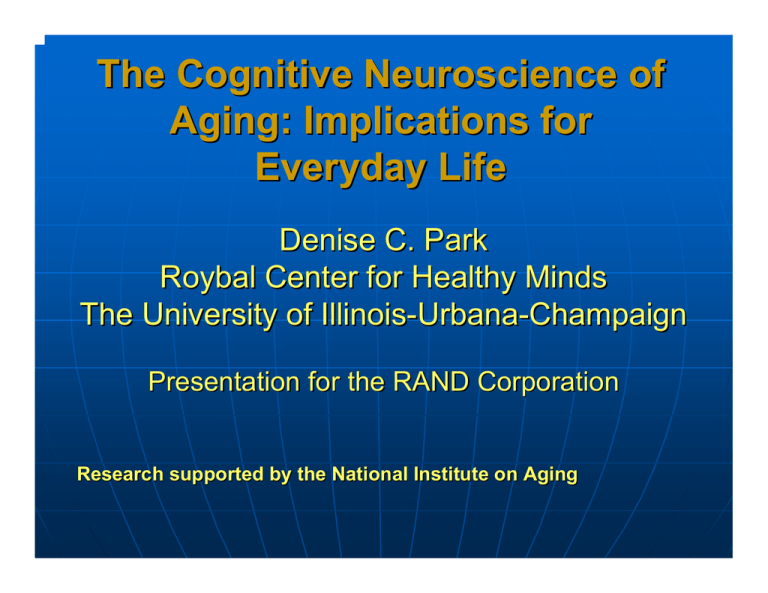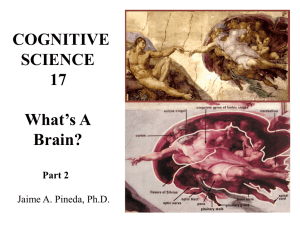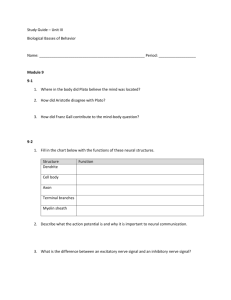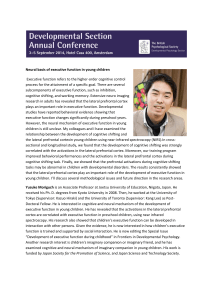The Cognitive Neuroscience of Aging: Implications for Everyday Life Denise C. Park
advertisement

The Cognitive Neuroscience of Aging: Implications for Everyday Life Denise C. Park Roybal Center for Healthy Minds The University of Illinois-Urbana-Champaign Presentation for the RAND Corporation Research supported by the National Institute on Aging Issues Addressed How does cognitive behavior change with age? (Part I) How does brain function change? (Part II) What are the implications of these processes and changes for every day life? (Part III) Part I. Laboratory Data Examining Cognitive Aging Building blocks of cognition: • Speed: how fast? • Working memory: how much? • Long-term memory: how durable? Conducted a large behavioral study across the lifespan, testing each subject for eight hours across three visits. 350 adults: 50 from each decade from 20-80 Pattern Comparison Task SAME DIFF (X) ( ) ( ) (X) (X) ( ) ( ) (X) Speed of Processing across the Lifespan: How fast? Z-scores 1.2 0.8 Digit Symbol 0.4 Letter Comparison 0 Pattern Comparison -0.4 n = 350 -0.8 -1.2 20's 30's 40's 50's 60's Age Groups 70's 80's Verbal Working Memory: How Much? a.a.99 b.b.15 15 c.c.10 10 Experimenter says: 6+3= Subject presses A, since 6 + 3 = 9. a.a.11 11 b.b.17 17 c.c.10 10 Experimenter says: 2+8= Subject presses C, since 2 + 8 = 10. Subject RECALLS 3 and 8 on paper. Working memory span is measured by how many trials people can go through without making an error on either the processing task (answering the equation) or the memory task (remembering the series of digits) Verbal and Visuo-spatial Working Memory Capacity across the Lifespan 1.2 Reading Span Verbal 0.8 Computation Span - Verbal Z-scores 0.4 Line Span Spatial 0 Letter Rotation - Spatial -0.4 n = 350 -0.8 -1.2 20's 30's 40's 50's 60's Age Groups 70's 80's Long-term Memory: How Durable? STUDY 24 words book dress song bank Wait 5 minutes Recall words Long-term Memory for Verbal and Visuo-spatial materials 1.2 Cued Recall Verbal 0.8 Free Recall Verbal Z-scores 0.4 Rey - Spatial 0 Benton Spatial -0.4 n = 350 -0.8 -1.2 20's 30's 40's 50's 60's Age Groups 70's 80's World Knowledge: Impact of Experience Measures of verbal ability • Vocabulary test • Synonyms • Antonyms Estimates of World Knowledge across the Life span 1.2 Shipley Vocabulary 0.8 Synonym Vocabulary Z-scores 0.4 Antonym Vocabulary 0 -0.4 n = 350 -0.8 -1.2 20's 30's 40's 50's 60's Age Groups 70's 80's The Aging Mind Digit Symbol 1.2 0.8 Letter Comparison Neurobiology: speed, working memory, long term memory Pattern Comparison Z-scores Letter Rotation Line Span 0.4 Computation Span 0 Reading Span Benton -0.4 Experience: world knowledge Rey Cued Recall -0.8 -1.2 20's Free Recall Shipley Vocabulary 30's 40's 50's 60's Age Groups 70's 80's n = 350 Park, Lautenschlager, Hedden,Davidson, Smith & Smith, 2002. Psychology and Aging Antonym Vocabulary Synonym Vocabulary What Do We Know About Cognitive Function with Age? Declines in process measures of “cognitive horsepower.” (hardware of the mind) Decline is linear and is quite similar across cross-sectional and longitudinal studies. Preservation and expansion of knowledge as as a result of experience. (software of the mind) There is also the ability to rely on highly practiced routines and utilize little cognitive horsepower. These are “automatic behaviors (e.g., driving). Implications of “horsepower” decline are greatest for novel situations in everyday life. Part II: Neural Function with Age Does neural circuitry change with age? Does less neural activation accompany decreased cognitive function with age? Do older adults rely on different neural circuitry? Does the brain remodel or rewire with age? Patterns of Neural Function with Age Startling dissociation between behavioral and neural data Unlike cognitive function, it appears neural activity increases rather than decreases with age Brain Areas Implicated in Cognition Frontal cortex: decision-making, strategies, conscious recollection Hippocampus (medial temporal cortex): repository of memory; locus of Alzheimer’s disease Visual/Sensory Cortex: Object recognition; less deterioration with age Frontal Cortex Reuter-Lorenz, et al., Journal of Cognitive Neuroscience, 2001 Hippocampal and Frontal Function in Old and Young Hippocampus is repository of memory. Processing of complex pictures is demanding of both hippocampal (memory) and frontal (strategy) areas About Research Participants Young (n = 11) Old (n = 10) Mean age =20.55 Mini Mental = 29.70 Vocabulary = 32.82 Accuracy visual: .837 Accuracy imaginal: .816 Mean age = 67.00 Mini Mental = 29.10 Vocabulary = 35.40 Accuracy visual: .827 Accuracy imaginal: .804 The Task Exten ded Recognition out of the scanner for pictures 3T Scanner Left Motor Cortex Young Red=Visual Blue=Imag Left Motor Cortex: Old Left Anterior Hippocampus Time Course Park, D.C., Marshuetz, C., Welsh, R., Gutchess, A., Mikels, J., Polk, T., & Taylor, S. (2003). Journal of Cognitive Neuroscience. Activations in Left and Right Inferior Frontal Areas During Probe Summary Behaviorally, old and young were identical Old, however, did not spontaneously “grab” information from the pictures to be stored in long-term memory (hippocampus) like young and showed decreased hippocampal function. However, at the time of the probe, old recruited more frontal cortex than young to perform the task and also had longer reaction times The frontal activations may be compensatory for the lack of hippocampal activations (subsequently reported by Gutchess, Welsh & Park (In press). Visual Cortex: Object Recognition and Aging Directed attention to early stages of processing: What does object recognition circuitry look like in old versus young? Decided to look at specialized areas in ventral-visual cortex Ventral Visual Cortex Shows little or no volumetric atrophy with age Highly specialized and activations should be easily interpretable Focus on fusiform face area (Kanwisher) Parahippocampal place area (Epstein & Kanwisher) Orthography area (Polk & Puce) Experimental Stimuli Face Pseudoword Chair House Phase-scrambled Results Isolated brain tissue (top 15 voxels) most active to faces. Then looked at how active were top face voxels to houses? Should see considerable segregation in young. But what about old? For each subject, developed a mask of ventral-visual cortex Within the mask, we functionally defined three ROI’s for each subject by selecting the 15 most activated voxels within ventral/vis cortex for faces, for places, and for pseudowords (relative to phased control items). These 15 voxels thus functionally defined the face, place, and word areas. We then calculated the mean t value of the activation in each of the three ROI’s to the four types of stimuli for young and old. Activation to Faces, Houses, Chairs and Pseudowords in Fusiform Face Area Face Area 8 Faces Houses Chairs Letters 7 6 Avg. t 5 4 3 2 1 0 Young Old Age Activations for Faces, Chairs, Houses and Pseudowords in PPA Place Area 7 Faces Houses Chairs Letters 6 5 Avg. t 4 3 2 1 0 Young Old -1 Age -2 Activation for Faces, Houses, Chairs and Pseudowords in Fusiform Word Area Pseudowords 7 Faces Houses Chairs Letters 6 5 Avg. t 4 3 2 1 0 Young Old Age Compelling Evidence for Decreased Neural Specialization with Age Repeatedly found evidence for decreased selectivity at the level of object recognition with age Behavioral theory suggests that this decreased selectivity is likely evidence for a deteriorating neural system Maybe older adults are slower and use more frontal function because they are sapping neural energy to perform basic functions like object recognition. Summary of Neural Data Decreased neural selectivity in ventral visual cortex with age. Decreased hippocampal activation with age (memory site). INCREASED frontal activation, likely as compensation for decreased activation of these other structures. Brain remodels and reorganizes with age. Part III. Basic Processes and Everyday Life What are the implications of declines in basic processes and changes in neural function for function in everyday life? Medical Adherence Medical Information Processing Effortful versus Automatic Processes Tasks that are effortful (require speed and working memory) show age related declines. There is little decline in automatic processes Automatic processes rely on feeling of familiarity about information and events so highly practiced that they require little capacity or effort. Examples of effortful processes would be recalling a list of words or trying to remember a grocery list; automatic would be listing months of the year , reading, or driving. Many important tasks in everyday life rely on automatic processes. An important way to get older adults to remember things is to utilize the part of memory that is still intact—the habitbased or automatic component of memory Medication Adherence This would appear to be a cognitive problem with multiple components. With age, there are • Decreases in comprehension of medication plan (Morrell, Park & Poon, 1989) • Decreases in memory of prescription information (Morrell, Park & Poon, 1990) Became interested in studying medication adherence in the field. Studying Adherence in Rheumatoid Arthritis Patients Studied a lifespan population of 122 rheumatoid arthritis patients for four weeks Used unobtrusive MEMS technology Collected exhaustive basic cognitive and psychosocial measures from subjects Chris Hertzog, Howard Leventhal, Roger Morell, Mike Martin Medical Adherence Errors Across a One Month Period as a Function of Age Average Proportion of Total Errors by Biweekly Periods 0.12 0.1 0.08 Biweek 1 0.06 Biweek 2 0.04 0.02 0 34-44 45-54 55-64 65-74 Age From Park, Hertzog, Leventhal, et al (1999) 75+ A Model of Adherence Behavior General Cognition Medication Nonadherence .38 .36 .51 .63 .43 .25 Busy Age .33 .29 .01 .61 Mood Control .17 Negative Affect Arthritis Efficacy .24 X²(56) = 70.34 NNFI = 0.96 CFI = 0.97 .31 Pain Control RMSEA = 0.065 R² = 0.39 From Park, et al. (1999) Who was most nonadherent? Middle-aged adults Busy people We believe that having a routine changes medication adherence from a memory behavior to an automatic behavior, so that busy people are most nonadherent Older adults took medications accurately in these studies Replicated this finding with hypertension medications Context over cognition, except in the case of very old adults where cognition matters Summary on Medication Adherence Context is more important than cognition Automatic processes may play an important role in medication adherence Began focusing on role of automaticity and unconscious cues in cognitive function. Target populations should be old-old and very busy people Increasing Compliance through Automatic Behaviors By attaching a behavior to a routine, it will be performed automatically. One way to artificially create automatic behaviors is to have individuals imagine implementing the behavior, creating cues that they will later encounter, and cause them to perform the behavior Using Automatic Processes To Improve Adherence Chasteen, Park and Schwarz (2001) demonstrated that they could improve memory for writing a date on a page by more than 100% if older adults imagined the intention compared to rehearsed the intention. Because automatic processes are preserved relative to effortful processes as people age, the use of implementation intentions may be a particularly valuable tool for increasing compliance among senior adults. Began work with Linda Liu Elite XL: A Microcurrent meter Glucose reacts with a catalyst in the test strip, releasing electrons. Electrons move to the electrodes, producing a current proportional to the amount of glucose in the Instruction conditions Control Deliberative Implementation "At (12:00 / 1:30 / 6:00 / 7:30), I will test my blood sugar." Rehearsed instructions out loud for 3 minutes. "Testing my blood may be slightly inconvenient, but it will help me decide what to eat." Generated pros and cons for 3 minutes. "At (12:00 / 1:30 / 6:00 / 7:30) when I am _______ , I will test my blood sugar." "Look around at your surroundings and concentrate on the objects in your environment. What do you see?____________ . " "Imagine the actions that lead up to what you will do at (12:00 / 1:30 / 6:00 / 7:30). What will you do?"______ "Imagine each step of each action, one at a time. What does each step feel like? _______ For each test time, handwrote responses to each question. Effects of Age and Instructions on Adherence Compliance for Weeks 1, 2, and 3 by Instruction-Elderly adults 6 7 5 Implementation Deliberative Control 4 Avg. number of readings per week Avg. number of readings per week Compliance for Weeks 1, 2, and 3 by Instruction-Younger adults 6 Implementation Control Deliberative 5 4 3 3 1 2 Week of study 3 1 2 Week of study 3 Conclusions By simple instructions that involved imagining completion of an act (blood-glucose monitoring), we greatly increased the probability that the act would be completed. The glucose task was automatically performed as a result of the instructions These effects are especially compelling, given that all of these participants were healthy and that learning to use this medical device was novel experience for them. One can argue, they may have had very little reason to care about testing their blood sugar. But reliance on automatic processes can also work against you. Can we make people think false information is true? How does memory decline cause older adults to come to believe false statements are true? Elderly often remember the gist of the information they hear but not the specific context in which they heard it or specific details There is a tendency to believe familiar information is true. What if you forget context but information feels familiar? Will this make false information seem true to you? We think that there is a possibility that the more older adults hear false information, the more likely they will be to believe later on that it is true. (Illusion of truth effect) • Skurnik, Park & Schwarz In press. Journal of Consumer Research General Procedure We developed a series of medical statements, all of which were true, but which subjects found to be unfamiliar and to have uncertain truth value. DHEA supplements can lead to liver damage, even when taken briefly. Most cold medications cause the eye’s pupil to dilate. Corn chips have twice as many calories per cup as potato chips. Experimental procedure • Present 36 claims as true or false Study Phase • 1/2 presented once, 1/2 three times • Inform participants 1/2 true, 1/2 false • Study Phase claims and new claims Test Phase • Remind participants 1/2 true, 1/2 false • True, false, or new? Experiment 1 results: After 1/2 hour Mean proportions of responses .45 .40 .35 .30 Response .28 .25 .20 "true" to false "false" to true .17 .15 .13 .11 .10 .10 .10 .06 .06 .05 .00 presented: 1x Younger 3x 1x Older 3x Mean proportions of responses Experiment 1 results: After 3 days .45 .40 .40 .35 .31 .30 .28 Response Type .25 .20 .19 .17 .16 .14 .15 .10 .08 .05 .00 1x 3x 1x presented: Younger Older 3x "true" to false "false" to true The Effects of Presenting Negative Information Presenting “myths” about a disorder may ultimately create false memories and beliefs. “Myths about diabetes.” • “Weight control doesn’t matter.” • “Medications easily control diabetes.” Information that an individual disbelieves at the time it is presented may come to seem true later on , particularly if the “myth” is repeated. Summary Aging mind can only be understood if cognitive function, experience, and context are jointly integrated. The impact of age-related decline is most apparent in a novel environment where experience and practice don’t confer any benefits. The effects of age-related decline, knowledge, and context are all powerful alone, but they interact in interesting ways as the data on medical adherence and false memories show. We need to understand the impact of novelty and stimulation on neural, cognitive and emotional functon. Part IV. Reorganizing Neural Function and Improving Cognition with Age New frontier and new focus of my laboratory. The Roybal Center for Healthy Minds




